How to Grow Eggplants: Beginner’s Guide to Thriving Plants
- March 13, 2024
- 0 comment
Eggplants (Solanum melongena) thrive in warm climates and require well-drained soil with plenty of sunlight. Start seeds indoors before the last frost, then transplant them into your garden, spacing them about 18 to 24 inches apart. Regular watering and fertilizing are key, and be vigilant about pests and diseases. Harvest eggplants when they’re firm and glossy for a delicious addition to a variety of dishes.

| Benefit | Description |
|---|---|
| Nutritional Value | High in fiber, vitamins B1, B6, and K, potassium, copper, and folate. Low in calories. |
| Antioxidant Properties | Contains nasunin, an anthocyanin, which fights free radicals and supports brain health. |
| Heart Health | Rich in fiber and bioflavonoids, which can lower the risk of heart disease. |
| Weight Management | Low in calories and high in fiber, helping in weight control and satiety. |
| Blood Sugar Control | High in fiber and low in soluble carbohydrates, aiding in blood sugar regulation. |
| Digestive Health | The fiber content supports healthy digestion and regular bowel movements. |
| Skin Health | Vitamins and minerals in eggplants can contribute to healthy skin. |
List on How To Grow Eggplants
- Selecting the Right Variety
- Planting and Timing
- Soil and Location
- Planting and Spacing
- Watering and Mulching
- Fertilizing
- Pest and Disease Management
- Harvesting
- Storage and Usage
Selecting the Right Variety
Eggplants come in various sizes, shapes, and colors. Some popular varieties include:
Black Beauty
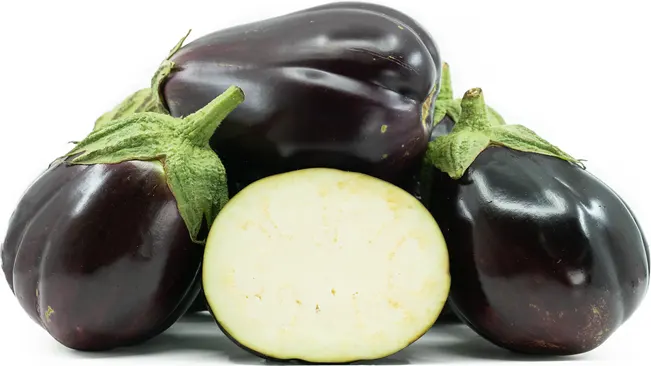
- Description: The ‘Black Beauty’ eggplant is one of the most classic varieties, known for its large, plump, bell-shaped profile.
- Color: It features a deep purple, almost black skin that is glossy and visually appealing.
- Flavor and Texture: This variety is known for its rich, mildly sweet flavor and creamy texture.
- Growth: It is a robust grower, typically yielding a good number of fruits per plant.
- Uses: Ideal for a range of dishes, including grilling, baking, and stuffing due to its large size.
Ichiban
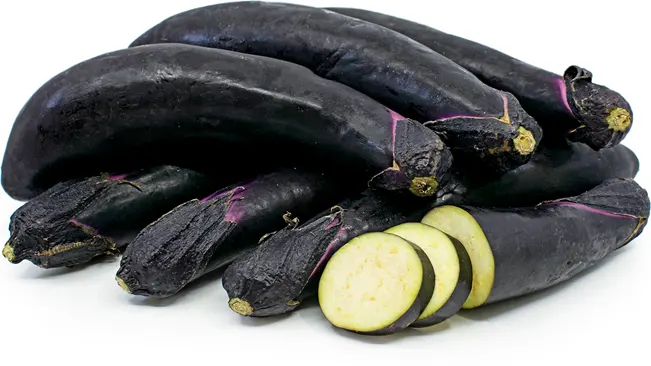
- Description: The ‘Ichiban’ is a Japanese variety of eggplant. It is distinct for its elongated, slender shape.
- Color: The skin is typically a deep purple, sleek, and thin, making it easy to cook and eat.
- Flavor and Texture: It has a tender texture and a sweeter flavor compared to other varieties.
- Growth: Ichiban eggplants grow well in warmer climates and are known for their prolific production.
- Uses: Perfect for stir-fries, grilling, and dishes where a delicate texture is desired.
White Eggplant
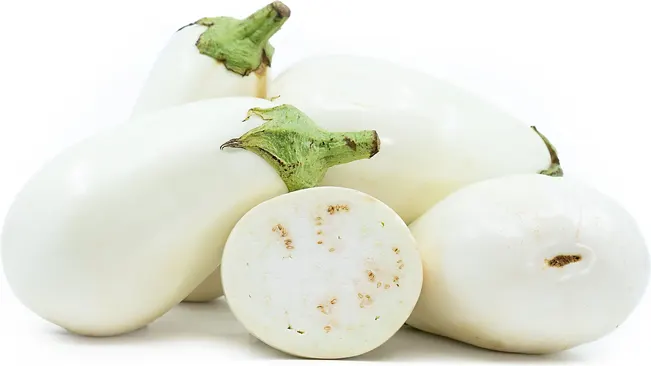
- Description: As the name suggests, this variety is small, rounded, and resembles an egg in shape.
- Color: It sports a unique white skin, which makes it stand out in the garden and on the plate.
- Flavor and Texture: The white eggplant has a more delicate, less acidic flavor and a tender texture.
- Growth: They tend to mature quickly and can be more delicate to grow than darker varieties.
- Uses: Great for baking, sautéing, or using in dishes where a subtle flavor is preferred.
Planting and Timing
Best Time to Plant

Eggplants are heat-loving plants and their growth is significantly impacted by the temperature. Planting them at the right time is crucial for a successful harvest.
- After the Last Frost: Eggplants are sensitive to cold and can be damaged by frost. It’s essential to wait until the danger of frost has passed. This is typically in late spring or early summer in most regions.
- Soil Temperature: The ideal soil temperature for planting eggplants is at least 55°F (13°C). Planting when the soil is too cold can slow down germination and growth.
- Warm Climate Adaptation: In areas with long, warm growing seasons, eggplants can flourish. They generally need a growing season of at least 100 to 120 frost-free days.
Starting from Seeds
Eggplants usually start as seeds before being transplanted into the garden. The process requires care and attention to detail.

- Indoor Start: Because of their long growing season and sensitivity to cold, starting eggplants indoors is a common practice. This head start allows them to mature fully during the warmer months.
- Timing: Begin 6 to 9 weeks before the anticipated last frost date. This timing gives the seedlings enough time to grow strong enough to withstand outdoor conditions.
- Peat Pots: Using peat pots can be beneficial. These pots can be planted directly into the soil, reducing transplant shock as you don’t have to remove the plant from the pot.
- Soil Moisture: Consistency is key. The soil should be kept moist but not waterlogged. Overwatering can lead to root rot, while under-watering can stress the plants.
Transplanting Seedlings
When the seedlings have grown and the outdoor conditions are suitable, it’s time to transplant them into your garden.

- Hardening Off: Before transplanting, acclimate the seedlings to outdoor conditions gradually. This process is known as “hardening off” and usually takes about a week.
- Transplant Timing: Choose a cloudy day or late afternoon to transplant, to reduce stress on the young plants.
Soil and Location
Soil Requirements
Eggplants are particularly sensitive to the condition of the soil in which they are grown.
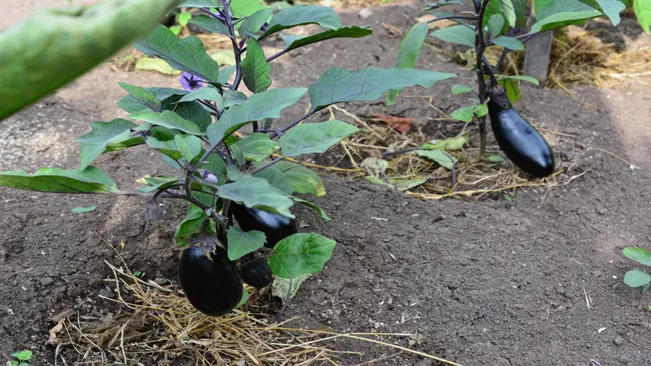
- Well-Drained Soil: Eggplants don’t do well in soggy soil. Good drainage is crucial to prevent root diseases and ensure healthy growth. If your garden soil is heavy or clayey, consider amending it with sand or organic matter to improve drainage.
- Soil pH: The ideal pH range for eggplants is slightly acidic to neutral, between 5.5 and 6.8. Soil pH affects nutrient availability, and staying within this range ensures that eggplants can absorb the nutrients they need. You can test your soil’s pH using a home testing kit and adjust it if necessary, using lime to raise the pH or sulfur to lower it.
- Organic Matter: Enriching the soil with compost or aged manure not only provides essential nutrients but also improves soil structure and water retention. Compost introduces beneficial microorganisms that aid in nutrient absorption and root health.
Sunlight
Sunlight is another critical factor for the successful cultivation of eggplants:
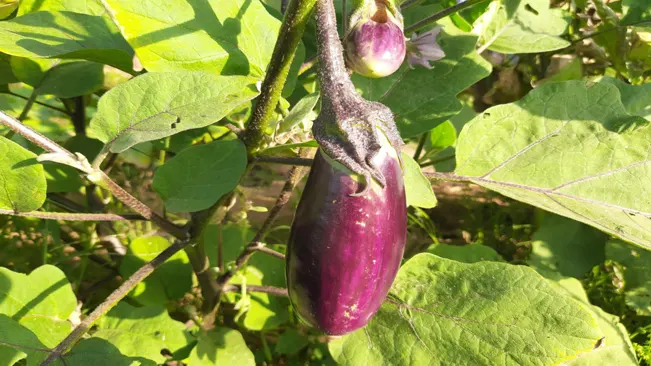
- Direct Sunlight: Eggplants require a lot of sunlight to develop properly. A minimum of 6 hours of direct sunlight per day is essential. This exposure is crucial for the plant to produce enough energy through photosynthesis to grow strong and healthy fruits.
- Location: When choosing a location in your garden, look for the sunniest spot. Avoid areas that are shaded by buildings or other plants, especially during the key sunlight hours of the morning and early afternoon.
- Temperature: Eggplants love warmth. They grow best in temperatures ranging from 70°F to 85°F (21°C to 29°C). If you live in a cooler climate, consider using row covers or planting in a greenhouse to maintain adequate warmth, especially during the early stages of growth.
Planting and Spacing
Planting and Spacing
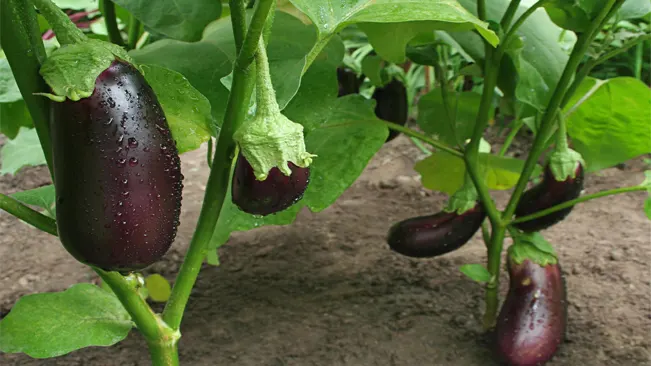
- Why Spacing Matters: Proper spacing is crucial for eggplants for several reasons. It ensures that each plant gets enough sunlight and air circulation, reducing the risk of diseases like fungal infections. It also allows for adequate root growth and access to nutrients, which are essential for healthy growth and fruit production.
- The Process: When you’re ready to plant eggplants in your garden, make sure each plant or seedling has enough space. Position them 18 to 24 inches apart from each other. This spacing allows each plant to grow without competing for sunlight, water, or nutrients. The rows should be spaced 30 to 36 inches apart. This distance is important for several reasons, including providing ample space for walking between rows during maintenance and harvesting, ensuring good air circulation, and making it easier to manage pests and weeds.
Transplanting Seedlings
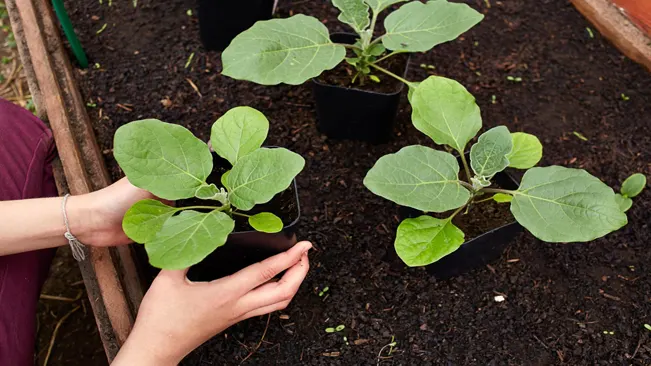
- Optimal Stage for Transplanting: Eggplant seedlings are best transplanted when they are young but established, typically when they have 3-4 true leaves. This stage indicates that the seedlings are strong enough to survive the transplant process and adapt to outdoor conditions.
- Transplanting Technique: The transplanting process should be gentle to avoid damaging the delicate roots of the eggplant seedlings. Disturbing the roots too much can stress the plants, leading to poor growth or even plant death. When removing seedlings from their initial pots or trays, handle them by the leaves rather than the stems, as the stems are more prone to damage. Dig a hole in the soil that’s large enough to accommodate the root ball of the seedling, and place the seedling in the hole at the same depth it was growing in the pot. Gently fill in around the roots with soil and press down lightly to eliminate air pockets.
Watering and Mulching
Watering Eggplants

- Deep Watering: This means watering the plants thoroughly so that moisture reaches deep into the soil. This encourages the roots to grow deeper, making them more robust and better able to access nutrients and water.
- Frequency: While the frequency depends on climate and soil type, a general rule is to water once a week with about an inch of water. In hotter, drier conditions, more frequent watering might be necessary.
- Signs of Over and Underwatering: Overwatered eggplants might have yellowing or dropping leaves, while underwatered plants will have wilted or dry leaves. The soil should feel moist but not soggy.
- Best Time to Water: Early morning is ideal because it allows water to soak into the soil before the heat of the day evaporates it.
Mulching Eggplants
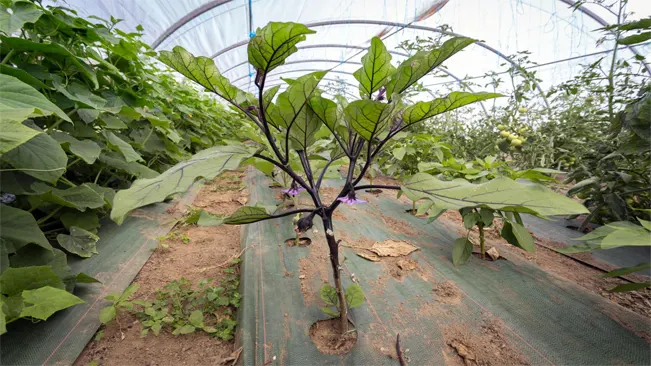
- Types of Organic Mulch: Suitable options include straw, grass clippings, shredded bark, or compost. These materials break down over time, adding nutrients back into the soil.
- Applying Mulch: Spread a 2-3 inch layer of mulch around the base of the plants, being careful not to let it touch the stems directly as this can cause rot.
- Benefits: Mulch helps maintain soil moisture by reducing evaporation. It also suppresses weed growth, which competes with eggplants for nutrients and water. Additionally, as organic mulch decomposes, it improves soil fertility and structure.
- Temperature Regulation: Mulch acts as an insulator for the soil, keeping it cooler on hot days and warmer during cool nights. This stability can be particularly beneficial for eggplants, which are sensitive to temperature fluctuations.
Fertilizing
Eggplants, being heavy feeders, require a consistent supply of nutrients throughout their growing season to produce a healthy and bountiful crop. Here’s what you need to know about fertilizing them:
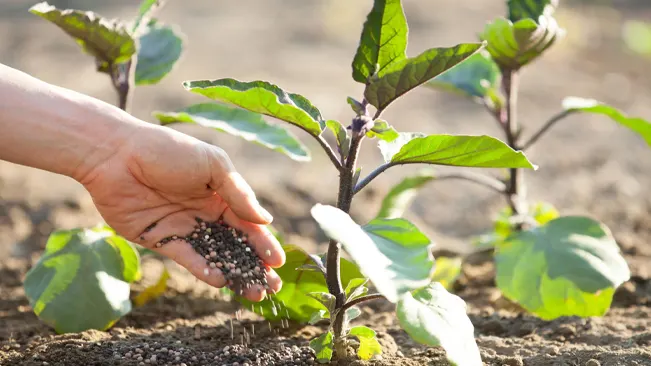
- Type of Fertilizer: A balanced fertilizer, often designated as 10-10-10, is ideal for eggplants. This numbering represents an equal ratio of the three primary nutrients plants need: Nitrogen (N), Phosphorus (P), and Potassium (K). Nitrogen promotes healthy leaf growth, phosphorus is essential for root and flower development, and potassium aids in overall plant health.
- Application Timing: Begin fertilizing about two weeks after transplanting the eggplants into your garden. At this stage, the plants are established enough to absorb and utilize the nutrients effectively.
- Frequency of Application: Fertilize your eggplants every few weeks. Consistent, regular feeding is crucial as eggplants grow and produce fruit. However, avoid over-fertilizing, which can lead to excessive foliage growth at the expense of fruit production.
- Method of Application: Apply the fertilizer around the base of the plants, avoiding direct contact with the stems or leaves to prevent burning. Water the soil well after applying the fertilizer to help distribute the nutrients evenly in the soil.
- Organic Options: For organic gardening, alternatives like compost, well-rotted manure, or organic balanced fertilizers can be used. These not only provide essential nutrients but also improve soil health and structure.
- Monitoring Plant Health: Observe your eggplants for signs of nutrient deficiencies or excesses. Yellowing leaves or stunted growth may indicate a need for more fertilizer, while overly lush foliage with few fruits suggests over-fertilization.
- Adjustments for Soil Conditions: Tailor your fertilization practices to your soil’s specific needs. If a soil test indicates high nitrogen but low phosphorus, for instance, choose a fertilizer with a lower nitrogen content.
Pest and Disease Management
Pest Management
- Flea Beetles: These small, jumping insects chew small holes in the leaves. To control them:
- Use floating row covers to protect plants.
- Implement a regular application of pyrethrin-based insecticides or diatomaceous earth.
- Aphids: These tiny bugs suck plant sap, causing leaf curling and stunted growth. Control methods include:
- Spraying with water to physically remove them.
- Introducing beneficial insects like ladybugs which feed on aphids.
- Applying insecticidal soaps or neem oil, especially under the leaves where aphids congregate.
- Spider Mites: These pests cause yellowing and speckling on leaves. To manage them:
- Increase humidity around plants, as mites prefer dry conditions.
- Use miticides or insecticidal soaps as a control measure.
- Regularly inspect the underside of leaves, as mites are tiny and often missed.
Disease Management
- Crop Rotation: Avoid planting eggplants or other nightshades (like tomatoes and peppers) in the same location year after year. This practice helps in preventing the buildup of soil-borne diseases.
- Air Circulation: Proper spacing between plants ensures good air flow. This reduces the humidity around the foliage, which is a breeding ground for many fungal diseases.
- Watering Practices:
- Avoid overhead watering to prevent wetting the foliage, as this can lead to fungal diseases like blight and mildew.
- Water at the base of the plant, preferably in the morning, to allow any splashed soil to dry during the day.
- Mulching: Applying mulch around the base of the plants can prevent the splashing of soil onto the leaves, which reduces the risk of soil-borne diseases.
- Regular Monitoring: Regularly inspect your eggplants for signs of disease, such as discolored leaves, stunted growth, or rot. Early detection is key to effective management.
Harvesting
When to Harvest
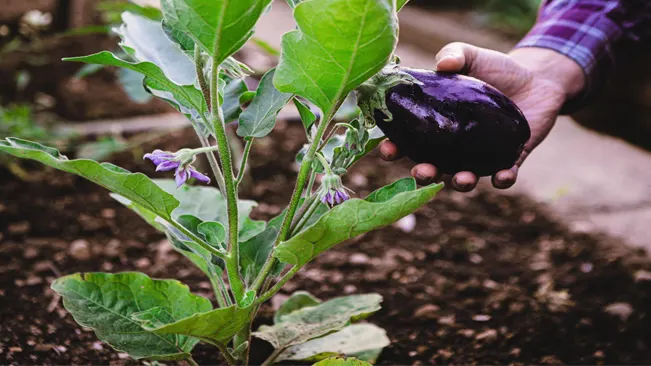
- Indicators of Ripeness: The ideal time to harvest eggplants is when they’ve reached their full size and the skin is smooth, shiny, and firm to the touch. The color should be vibrant, which varies based on the variety (deep purple, white, green, etc.). The flesh should give a slight yield under gentle pressure but shouldn’t feel too soft.
- Timeliness: It’s crucial to harvest before they become overripe. Overripe eggplants can have a bitter taste and a spongy texture. A simple test is to press the skin lightly; if it springs back, it’s ripe. If the indentation remains, it’s overripe.
- Size Matters: Pay attention to the expected size of your specific variety at maturity, as this can vary widely from one type to another.
Harvesting Technique
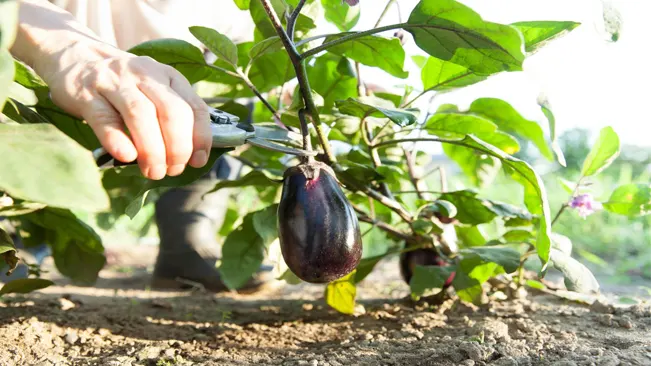
- Using Pruning Shears: Always use a sharp pair of pruning shears or a knife. This ensures a clean cut, which is less damaging to the plant and the fruit.
- Cutting: Cut the eggplant off with a short piece of the stem attached. This not only helps in handling the fruit but also prolongs its shelf life post-harvest.
- Handling Care: Eggplants can bruise easily, so handle them gently. Bruising can lead to decay and reduce the quality of the fruit.
- Frequency: During the peak of the season, check your plants every few days. Regular harvesting encourages the plant to produce more fruit.
Post-Harvest Tips

- Immediate Use: Eggplants are best used fresh. However, if you need to store them, keep them in a cool, dry place, preferably in the refrigerator.
- Storage: They can be stored for about a week in the refrigerator but be mindful that cold storage can affect their texture and flavor.
- Preparation: Before using, wash the eggplant and trim off the stem. They can be cooked in various ways – grilled, roasted, sautéed, or used in stews and curries.
Storage and Usage
Storage Tips
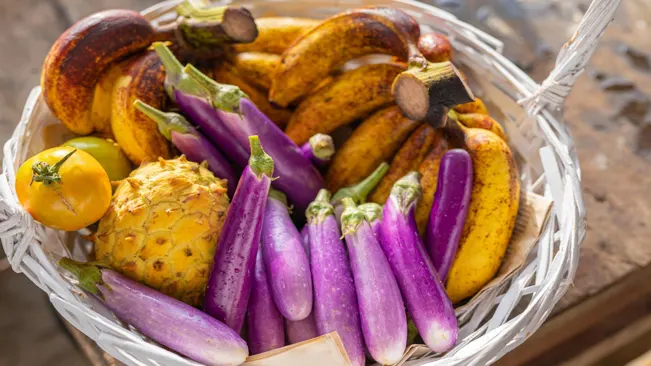
- Short-Term Storage: If you plan to use eggplants within a couple of days, it’s best to keep them at room temperature. This helps to maintain their texture and flavor. Keep them in a cool, dry place away from direct sunlight.
- Long-Term Storage: For storage beyond a few days, place eggplants in the crisper drawer of your refrigerator. They can last up to one week when refrigerated, but it’s good to use them as soon as possible since they can become bitter with time.
- Avoiding Moisture: Keep eggplants dry as excess moisture can lead to decay. Don’t wash them until you’re ready to use them.
- Prevent Bruising: Handle them with care as they bruise easily. Bruised areas tend to spoil faster.
Culinary Uses

- Ratatouille: This classic French stewed vegetable dish features eggplant as a star ingredient, combined with tomatoes, zucchini, bell peppers, and onions, seasoned with herbs.
- Baba Ganoush: A popular Middle Eastern dip, baba ganoush is made by roasting eggplants until soft, then blending them with tahini, garlic, lemon juice, and various seasonings.
- Grilling and Roasting: Eggplants can be sliced and grilled or roasted, which brings out their natural sweetness and gives them a smoky flavor. They can be used in sandwiches, as a side dish, or in salads.
- Stuffed Eggplants: The flesh of eggplants can be scooped out and mixed with other ingredients like meats, grains, vegetables, and spices, then restuffed and baked.
- Asian Cuisine: In Asian cuisines, eggplants are often stir-fried or braised, commonly flavored with soy sauce, garlic, ginger, and other spices.
Conclusion
To successfully grow eggplants, start by choosing a warm, sunny location and enrich the soil with compost. Plant after the last frost, spacing them adequately, and ensure consistent watering and fertilization. Protect them from pests and harvest when they’re glossy and firm for a bountiful yield of this versatile vegetable.
FAQs (Frequently Asked Questions)
- What is the best time to plant eggplants?
Plant eggplants after the last frost when the soil temperature is at least 55°F (13°C), typically in late spring or early summer. - How long does it take for eggplants to grow?
Eggplants generally take about 70 to 100 days to reach maturity, depending on the variety. - Do eggplants need full sun?
Yes, eggplants thrive in full sun, requiring at least 6 to 8 hours of direct sunlight each day. - How much water do eggplants need?
Eggplants need regular, consistent watering, especially during dry periods. Water deeply once or twice a week, depending on weather conditions. - What type of soil is best for eggplants?
Eggplants prefer well-drained soil rich in organic matter, with a pH between 5.5 and 6.8. - How far apart should I plant eggplants?
Space eggplant seedlings about 18 to 24 inches apart, in rows that are 30 to 36 inches apart. - Do I need to stake eggplants?
Staking is recommended for eggplants, especially for taller varieties, to support the plant as the fruit grows. - What are common pests and diseases for eggplants?
Common pests include flea beetles, aphids, and spider mites. Diseases like blight and mildew can also affect eggplants. - When should I harvest eggplants?
Harvest when the skin is shiny and the fruit is firm but slightly spongy. Overripe eggplants can become bitter and tough. - How do I fertilize eggplants?
Use a balanced fertilizer (like a 10-10-10) every few weeks. Eggplants are heavy feeders and benefit from regular fertilization.

Kristine Moore
Forestry AuthorI'm Kristine Moore, a seasoned garden landscaping professional with over 30 years of experience. My extensive career has been dedicated to transforming outdoor spaces into stunning, sustainable landscapes. With a deep understanding of horticulture, design principles, and environmental stewardship, I have become a respected figure in the field, known for creating harmonious, visually appealing, and eco-friendly gardens. My commitment to excellence and continuous learning in landscaping trends and techniques has solidified my reputation as an expert in garden design and implementation.

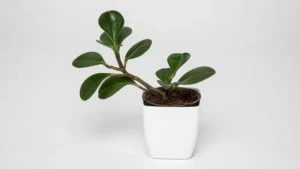










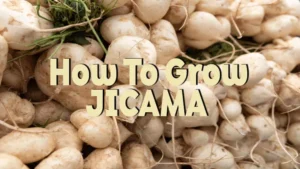
Leave your comment